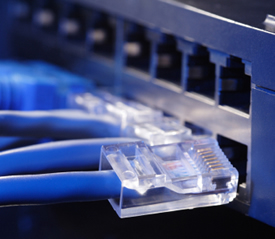We rely on our computers to not only help us work faster but work efficiently as well. When our company’s network is not operating, our ability to work comes to a halt. Over the last 14 years in the computer field, client network complaints seem to fall into one of the following categories…lack of speed, dropped network connections, and slow network connections during peak work hours.
Consistent lack of network speed is usually attributed to old equipment. It is surprising just how many companies still utilize an old wireless B network simply because it still works. The amount of time wasted waiting for files to finish transferring will justify the upgrade. Simply replacing the router and / or switch brings the increase in network performance to create an optimal working environment.
to old equipment. It is surprising just how many companies still utilize an old wireless B network simply because it still works. The amount of time wasted waiting for files to finish transferring will justify the upgrade. Simply replacing the router and / or switch brings the increase in network performance to create an optimal working environment.
Network connection drops are usually attributed to faulty equipment…whether it be an individual network interface card (NIC) or a malfunctioning router. If one of your hard wired (Ethernet) computers constantly loses connection to the network, more than likely you will need to replace the NIC. (Network Interface Card) In cases of an onboard NIC (a network interface connection built into the motherboard) the onboard NIC will need to be disabled (in the BIOS) and a USB, PCI or PCI Express NIC will need to be installed.
Random loss of network connections throughout your entire network of computers hints towards router & switch failure or in some cases bad Ethernet wiring. If your router is more than 3 years old, consider buying a new one. You will enjoy the performance boost a new router will add to your network. It is important to note that an old $50 router is a ticking time bomb in an office. It is going to die, and when it does, it will not be when it is most convenient.
 Slow network connections in an office setting can be attributed to a few common issues. One issue that is often overlooked is the type of Ethernet wiring present in their location. In order to obtain gigabit transfer speeds, a network must be using not only gigabit switches and NICs, it must also have Ethernet wiring capable of gigabit data rates.
Slow network connections in an office setting can be attributed to a few common issues. One issue that is often overlooked is the type of Ethernet wiring present in their location. In order to obtain gigabit transfer speeds, a network must be using not only gigabit switches and NICs, it must also have Ethernet wiring capable of gigabit data rates.
Cat 5E is the oldest Ethernet wiring that is capable of transmitting data at today’s gigabit speeds. Cat 6 and in some cases Cat 7 wiring is the standard for new office network installations. If your office has Cat 5 Ethernet wiring or less, it is time to upgrade the Ethernet wiring in your office.
Not sure which type of Ethernet wire you have? Take a look at the side of the Ethernet cables running throughout the office. Amongst the writing on the cable will be the word “Cat” (short for category) followed by a number. Go through every wire in your office…if you are lucky, you may only have one or two old Ethernet wires that are causing your bottleneck.
Once the Ethernet wiring is determined to be sufficient, you may now look at the rest of the equipment in the office. However, before you go shopping for the latest and greatest networking equipment, ask yourself the following questions.
1) How many devices will be using the network during peak hours? (Wired & Wireless)
2) What type of files will be transmitted over the home or office network? (Are you accessing word and excel documents which are small in size, or are you streaming large music and video files?)
3) Do you want room for future expansion without having to purchase new equipment?
If you are living in a small apartment with your significant other and have no more than 5 – 6 networked devices connected at one time, an over the counter $50-$60 Netgear or Linksys router will serve you well. The same can be true for a small office of 5-6 networked devices, including printers, VOIP phones, and much much more…though make sure the router has gigabit ports which in theory are ten times faster than their 100 Mbps ancestors.
Once your network has grown to include a myriad of networked devices, whether it be in a home or office, it is time to consider upgrading to something more substantial than the typical all-in-one Netgear or Linksys router. Today’s homes rival small offices when one considers the sheer number of wired and wireless networked devices. If you constantly have to reboot your home router consider some of the following upgrade options.
 For the novice, consider adding a larger, more powerful gigabit switch to your existing router. If you simply ran out of ports on the back of your trusty Linksys, adding a $40 8-port gigabit switch will allow you to hard wire more devices to your existing network. Try to incorporate the fewest switches possible into a system. It is better to use one 24-port network switch than three 8-port switches.
For the novice, consider adding a larger, more powerful gigabit switch to your existing router. If you simply ran out of ports on the back of your trusty Linksys, adding a $40 8-port gigabit switch will allow you to hard wire more devices to your existing network. Try to incorporate the fewest switches possible into a system. It is better to use one 24-port network switch than three 8-port switches.
Another option for the more determined individual would be the addition of a high powered access point to an existing router. The access point will provide a more powerful wireless network signal capable of handling numerous wireless devices. While a typical $50 wireless router is good for 5-6 wireless devices, a $100 access point is often rated for up to 100 wireless devices. This route often works best when your internet service provider requires the use of their own equipment…ie: Verizon FIOS and a handful of other ISPs. Keep in mind though, you will need to program the access point to your existing router before it can be used. Most access points now come with easy to use software that makes setup a breeze.
Before jumping into the next segment of high end networking equipment, take a look at your present setup and consider the following. Large corporations have dedicated server rooms that are air conditioned. It is easier to think of these rooms like a computer case. A computer case houses all of the equipment in a conditioned environment. The case fans pull cooler ambient air into the case to keep operating temperatures down. Is your networking equipment placed in a cool location? Is there adequate space around each component to allow sufficient air flow? Often I walk into an office only to find brand new networking equipment installed in a cabinet with zero ventilation. From the cheapest all-in-one wireless router to the most expensive barracuda firewall, networking equipment must be able to breathe. If your equipment runs hot, it will run slow…this is true for networks in both offices and in homes. Place your networking equipment in an area with good ventilation and take your time to properly route those Ethernet wires…and avoid that bird’s nest appearance that so often exists.
If your networking needs are greater than a few simple upgrades and you are fortunate enough to use your own equipment, step into the world of dedicated equipment. Similar to high end audio equipment, dedicated pieces are more powerful than the most expensive all-in-one wireless routers. If your home or office requires heavy duty networking capability, a dedicated router, switch and access point will handle your appetite for multiple high speed file transfers. Keep in mind, this type of networking equipment is designed to be installed by a professional. Easy to use installation manuals are almost non-existent. Though some manufacturers have forums and technical support that offer help to the most determined DIYer.
In the world of networking equipment, your budget is the only limit. As with all technology, there exists a point of diminished returns. The newest equipment may cost twice as much when compared to last years models, but may only yield a 10% increase in performance. When considering a network upgrade for your home or office, it is important to understand the limits of your present setup. What features do you want now and in the future? Allow yourself room for expansion. If you already have 8 devices that need to be hard wired to your network, buy a 16-port switch. You won’t have to buy another switch next month when you unexpectedly add another office printer. Finally, you rely on your network everyday to keep your business running smoothly. Take your time to research, plan and properly install your home or office network. The right networking equipment will provide you with years of optimal working conditions.
Support Our Blog by Visiting Our Sponsors
Tags: computer,network,networking,upgrade,wired,wireless,router,switch,gigabit,nic,ethernet,access point
Copyright © 2008
This feed is for personal, non-commercial use only.
The use of this feed on other websites breaches copyright. If this content is not in your news reader, it makes the page you are viewing an infringement of the copyright. (Digital Fingerprint:
cc39fd6fcd0ccd45e70630a348dba507)The post Computer Network Upgrades – Wired & Wireless – A DIY Primer first appeared on The Cyber Fusion, Inc.























